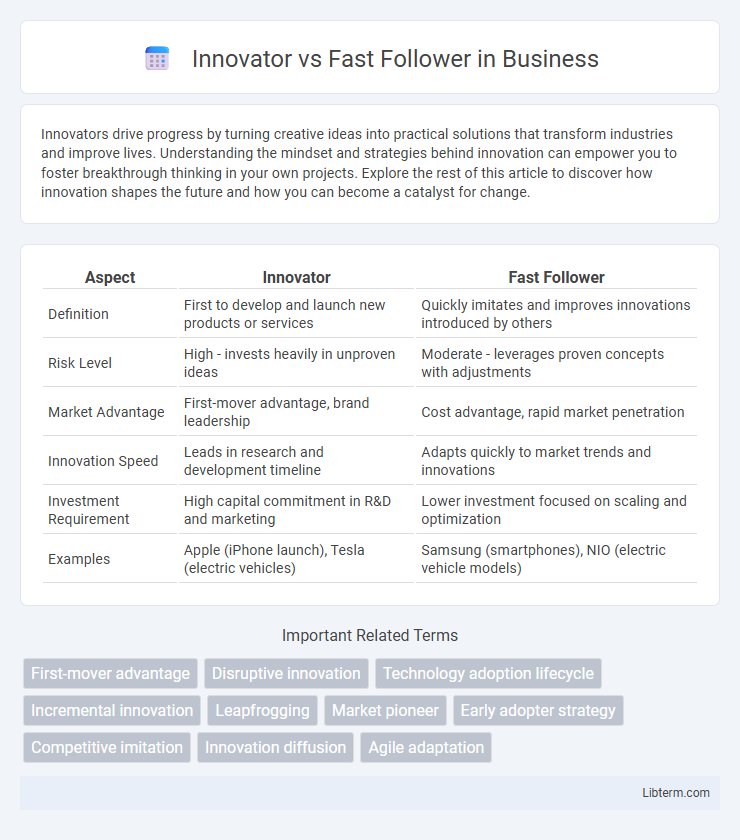Innovators drive progress by turning creative ideas into practical solutions that transform industries and improve lives. Understanding the mindset and strategies behind innovation can empower you to foster breakthrough thinking in your own projects. Explore the rest of this article to discover how innovation shapes the future and how you can become a catalyst for change.
Table of Comparison
| Aspect | Innovator | Fast Follower |
|---|---|---|
| Definition | First to develop and launch new products or services | Quickly imitates and improves innovations introduced by others |
| Risk Level | High - invests heavily in unproven ideas | Moderate - leverages proven concepts with adjustments |
| Market Advantage | First-mover advantage, brand leadership | Cost advantage, rapid market penetration |
| Innovation Speed | Leads in research and development timeline | Adapts quickly to market trends and innovations |
| Investment Requirement | High capital commitment in R&D and marketing | Lower investment focused on scaling and optimization |
| Examples | Apple (iPhone launch), Tesla (electric vehicles) | Samsung (smartphones), NIO (electric vehicle models) |
Understanding the Innovator and Fast Follower Models
Innovator models emphasize pioneering new technologies and market disruption through bold research and development investments, setting trends that reshape industries. Fast followers prioritize rapid adoption and adaptation of existing innovations, leveraging proven concepts to efficiently capture market share with lower risk. Understanding these distinct strategic approaches helps businesses align their resources and competitive tactics for sustained growth and innovation management.
Key Characteristics of Innovators
Innovators are characterized by their high risk tolerance, pioneering mindset, and commitment to creating groundbreaking products or services. They emphasize original research, invest heavily in R&D, and often disrupt existing markets by introducing novel technologies or business models. Their agility and vision enable them to set industry standards and capture early adopter attention.
Core Traits of Fast Followers
Fast followers excel in rapid market adaptation, leveraging established innovations to quickly capture market share. They prioritize efficient resource allocation and iterative improvement over disruptive invention, enabling them to minimize risks associated with first-mover uncertainties. Their strategic advantage lies in refining proven products while maintaining agile response to emerging consumer trends and competitor actions.
Advantages of Being an Innovator
Innovators gain a competitive edge by setting market trends and establishing brand authority early, attracting loyal customers and commanding premium pricing. They benefit from first-mover advantages, including securing patents and creating barriers to entry that slow down competitors. This proactive approach accelerates learning curves and technological mastery, driving sustained growth and industry leadership.
Benefits of the Fast Follower Strategy
The Fast Follower strategy offers significant advantages by allowing companies to learn from the mistakes and successes of innovators, reducing the risks associated with launching new products. Fast followers benefit from lower research and development costs and can capitalize on proven market demand, accelerating their time-to-market. This approach enables quicker adaptation to consumer preferences and technology trends, often resulting in sustained competitive advantage.
Risks and Challenges Faced by Innovators
Innovators face significant risks including high financial investment, market uncertainty, and potential failure due to unproven concepts. They encounter challenges in securing customer adoption, managing rapid technological changes, and overcoming regulatory hurdles. These factors contribute to increased pressure on innovators to balance innovation speed with strategic planning to sustain competitive advantage.
Common Pitfalls for Fast Followers
Fast followers often struggle with delayed market entry due to over-reliance on existing innovations, which reduces their competitive edge against true innovators. They risk underestimating the speed of technological change, leading to outdated or less differentiated offerings. Missing the opportunity to build strong brand loyalty and failing to anticipate shifts in consumer preferences are common pitfalls that can stifle their long-term growth.
Industry Examples: Innovators vs Fast Followers
Tesla revolutionized the automotive industry as an innovator by pioneering electric vehicles and autonomous driving technology, setting new standards in sustainability. In contrast, companies like General Motors act as fast followers, rapidly adopting and refining these innovations to capture market share and meet evolving consumer demands. This dynamic showcases how innovators drive breakthrough advancements while fast followers capitalize on proven technologies to optimize production and scale.
Choosing the Right Approach for Your Business
Choosing the right approach between innovator and fast follower depends on your business's resources, risk tolerance, and market dynamics. Innovators leverage cutting-edge technology and unique ideas to disrupt industries and capture early market share, often requiring significant investment and tolerance for uncertainty. Fast followers capitalize on proven concepts, refining and scaling innovations with lower risk and faster time-to-market, ideal for businesses aiming for sustainable growth and competitive positioning.
Future Trends: Innovation and Fast Following
Innovators drive future trends by pioneering cutting-edge technologies and setting new market standards, often capturing significant competitive advantages through early adoption. Fast followers capitalize on these established innovations, rapidly scaling and optimizing them to meet broader consumer demands with reduced risk. This dynamic enables fast followers to leverage proven innovations for sustainable growth while innovators continue pushing the boundaries of industry evolution.
Innovator Infographic

 libterm.com
libterm.com